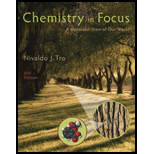
Concept explainers
Which property is not generally associated with acids?
sour taste
volatility
ability to neutralize bases
ability to dissolve metals
Interpretation:
Out of the given options, the incorrect property regarding acids is to be determined.
Concept Introduction:
Acid is a molecule or an ion capable of releasing a proton (or hydrogen ion,
Answer to Problem 1SC
Correct answer: Option (b).
Explanation of Solution
Reason for the correct option:
Acids generally form polar covalent bonds, where a pair of electrons is unequally shared between the two atoms because of their electronegativity difference. It is a type of covalent bond that tends to hold atoms or molecules together and this makes it difficult for molecules to escape as vapour.
Hence, option (b) is correct.
Reason for the incorrect options:
Option (a) is incorrect because acidic foods are believed to taste sour because of hydrogen ion
Option (c) is incorrect because acids show neutralization reaction in which they neutralize bases into their respective salts and involvement of
Option (d) is incorrect because acids readily donate protons (or hydrogen ions
Hence, options (a), (c), and (d) are incorrect.
Want to see more full solutions like this?
Chapter 13 Solutions
Chemistry In Focus
- Explain the difference between a monoprotic acid, a diprotic acid, and a triprotic acid. Give an example of each.arrow_forward(a) What is the pH of a 0.105 M HCl solution? (b) What is the hydronium ion concentration in a solution with a pH of 2.56? Is the solution acidic or basic? (c) A solution has a pH of 9.67. What is the hydronium ion concentration in the solution? Is the solution acidic or basic? (d) A 10.0-mL sample of 2.56 M HCl is diluted with water to 250. mL What is the pH of the dilute solution?arrow_forward. Why do scientists tend to express the acidity of a solution in terms of its Ph, rather than in terms of the molarity of hydrogen ion present? How is pH defined mathematically?arrow_forward

 Chemistry: The Molecular ScienceChemistryISBN:9781285199047Author:John W. Moore, Conrad L. StanitskiPublisher:Cengage LearningChemistry: Matter and ChangeChemistryISBN:9780078746376Author:Dinah Zike, Laurel Dingrando, Nicholas Hainen, Cheryl WistromPublisher:Glencoe/McGraw-Hill School Pub Co
Chemistry: The Molecular ScienceChemistryISBN:9781285199047Author:John W. Moore, Conrad L. StanitskiPublisher:Cengage LearningChemistry: Matter and ChangeChemistryISBN:9780078746376Author:Dinah Zike, Laurel Dingrando, Nicholas Hainen, Cheryl WistromPublisher:Glencoe/McGraw-Hill School Pub Co Introductory Chemistry: An Active Learning Approa...ChemistryISBN:9781305079250Author:Mark S. Cracolice, Ed PetersPublisher:Cengage Learning
Introductory Chemistry: An Active Learning Approa...ChemistryISBN:9781305079250Author:Mark S. Cracolice, Ed PetersPublisher:Cengage Learning Chemistry & Chemical ReactivityChemistryISBN:9781337399074Author:John C. Kotz, Paul M. Treichel, John Townsend, David TreichelPublisher:Cengage Learning
Chemistry & Chemical ReactivityChemistryISBN:9781337399074Author:John C. Kotz, Paul M. Treichel, John Townsend, David TreichelPublisher:Cengage Learning Chemistry & Chemical ReactivityChemistryISBN:9781133949640Author:John C. Kotz, Paul M. Treichel, John Townsend, David TreichelPublisher:Cengage Learning
Chemistry & Chemical ReactivityChemistryISBN:9781133949640Author:John C. Kotz, Paul M. Treichel, John Townsend, David TreichelPublisher:Cengage Learning





